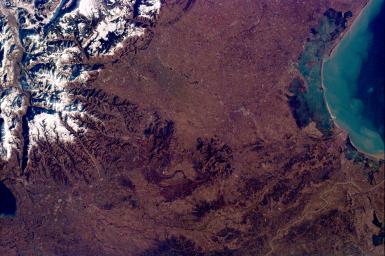This KidSat image spans the region of Venetia from the city of Venice, Italy, on the coast of the Adriatic Sea north to the snow-capped Alps. Venice appears in the lower left part of the image, and the Alps appear in the lower right. This image is 97.78 km long by 146.31 km wide and is centered at 45.56 degrees north latitude, 11.48 degrees east longitude. Due to shuttle orientation, north is located at approximately ten o'clock in this image. It was taken by the KidSat electronic still camera, using a 50 mm lens, from the Space Shuttle Atlantis at an altitude of 264.57 km. The image was requested by the Buist Academy Student Mission Operations Center in Charleston, South Carolina. The students will use the image in their classrooms to study the rivers and channels of Venice and to compare the cities of Venice and Paris, France. Venice's Grand Canal is barely visible in the image.
Venice was one of the centers of science, knowledge and art during the Renaissance, as well as a major trade center for goods from Asia. Located near fishing and forest resources, it was first settled by a variety of people that included war refugees from Troy and immigrants from what are now the Slavic nations. The first settlement, consisting mostly of wood buildings, was destroyed after a massive sea quake; little remains of the original city. Settlements spread to encompass the islands in the mouth of the river Brenta and now cover a total 117 islands. In the nearby Alps are several waterfalls which, since 1977, have been the site of many ice climbing missions.
KidSat gives students across the country a chance to view and learn about Earth using and commanding their own instruments in space. The KidSat project is a result of the effort and collaboration of NASA's Jet Propulsion Laboratory, Johns Hopkins University's Institute for Academic Advancement of Youth and the University of California, San Diego. Kidsat includes a payload of digital still and video cameras that fly on the Space Shuttle. Students operate these cameras from their classrooms, sending instructions to the Kidsat Mission Control Center at UC San Diego via the Internet to photograph specific regions of Earth they wish to study. Image data are sent to the Kidsat Data System at JPL during the mission and these images are accessible in the classroom in near-real time, again using the Internet. At JPL, students on the exploration team research the images. The KidSat project allows students to explore Earth from space and learn about its past and its fragile, ever-changing environment.
Images and student results will be posted on the KidSat home page. Interested public school districts, teachers, and students may view the images and information provided by students during the mission via this World Wide Web site:
http://www.jpl.nasa.gov/kidsat
The KidSat pilot program is sponsored by NASA's Office of Human Resources and Education, with support from the Offices of Space Flight, Mission to Planet Earth and Space Science.
Photojournal note: The website formerly known as KidSat was renamed EarthKAM in 1998: http://www.earthkam.ucsd.edu/.

 Planetary Data System
Planetary Data System












